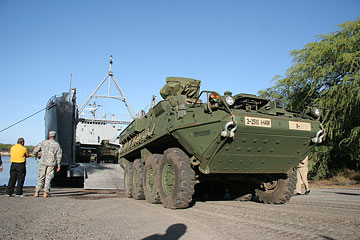 STAR-BULLETIN / MAY 2007 A Stryker military combat vehicle disembarks at Waipio Point. The Strykers are part of the U.S. Army's force in the Pacific. CLICK FOR LARGE |
|
Pacific force 'more deployable'
Lt. Gen. John Brown is in charge of building a fast, versatile Army
What Gen. Eric "Rick" Shinseki foresaw as the future of the U.S. Army is slowly taking shape as the fighting force in the Pacific becomes more mobile, more flexible and more deployable.
The task of transforming the troops in the Pacific over the past three years has fallen to Lt. Gen. John Brown, who has watched the Army grow by more than 10,000 soldiers since he assumed command.
Brown said Shinseki, when he became Army chief of staff in 1999, envisioned an Army that could "respond faster when needed."
It was the Kauai-born Shinseki who envisioned a "modular, expeditionary Army that could move more rapidly to where it was needed around the world with more of it stationed in the continental United States and a smaller percentage stationed outside the United States," Brown said.
Part of Shinseki's conceptual change in the Army's warfighting capabilities was a fighting force supported by Strykers, 19-ton, eight-wheeled combat vehicles.
Since the end of the war in Vietnam, Brown said, the Army in the Pacific has had "an economy of force" because most of the money and military energy was focused on other parts of the world, mainly Europe in the Balkans and the Middle East, Brown added.
Within the past few years, however, the focus has changed. All of the battalion- and brigade-level forces in the Pacific, Brown said, have been beefed up with more soldiers and re-equipped to make them more self-sustaining.
That means "there are more forces available and they are now in a much more deployable, sustainable package, so they can respond faster to where they are needed," he said.
Both the 25th Infantry Division's 2nd Brigade Combat Team, now fighting in Iraq, and the Hawaii Army National Guard's 29th Brigade Combat Team were among units included in that change.
Many of the changes in the Army's combat structure in the Pacific were implemented because of the need to protect U.S. soldiers from missile and rocket attacks.
At the request of the Pacific Command, the Army two years ago established at Fort Shafter the 94th Army Air Missile Defense Command. It became the second air defense system in the Army. On Wednesday, Brig. Gen. Roger Matthews will assume command of the 800-member missile unit with 200 soldiers stationed at Fort Shafter.
The change meant the relocation of an Army Patriot missile battalion from Fort Bliss in Texas to Okinawa last year.
Besides the 94th Army Air Missile Command, other changes in the Army's structure in the Pacific includes the creation of:
» the Eighth Theater Sustainment Command, which was established in September and is responsible for directing and overseeing the Army's logistical needs in the Pacific. Its 460 soldiers are led by Brig. Gen. William Bradenburg.
» the 311th Signal Command, which moved to Fort Shafter from Maryland 18 months ago where it was an Army Reserve unit. Led by Maj. Gen. Donna Dacier, it is now a combined active Army and Army Reserve unit that eventually will have 210 soldiers. Its mission is to manage the Pacific portions of the Army's global communication network.
The new Pacific Army command structure -- which Brown heads and extends from the West Coast to Japan -- will fall under what is now called the Theater Army Headquarters.
"What that means," Brown said, "is that we will continue to do what we have for decades -- providing Army forces to the PACOM commander (Adm. Timothy Keating) when he needs them."
Brown said the change means that the Army will have a tactical warfighting headquarters that can deploy anywhere in the Pacific to direct a ground war for Keating. The Army says the deployable headquarters unit will have 1,050 soldiers.
Across the Pacific, Brown said, he commands 47,000 soldiers, up 10,500 since he assumed command in 2004. However, that figure doesn't include 3,000 soldiers in South Korea who fall under the 8th Army and who will remain on the peninsula as the Pentagon's major warfighting ground force.
Eventually, Brown said the Pacific Army command could assume all the support service for the combat Army forces in South Korea.
By 2010, when the entire transformation in the Pacific force is supposed to be completed, Brown estimated that his force will be about 55,000 soldiers.

